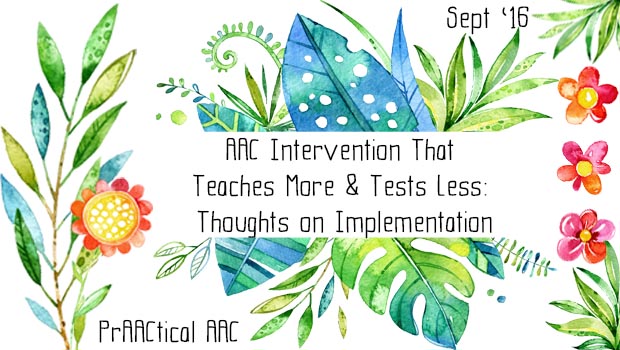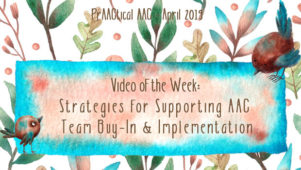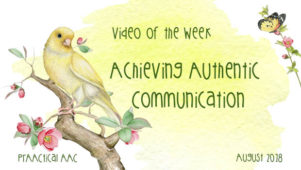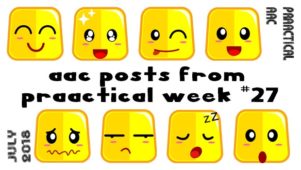AAC Intervention That Teaches More and Tests Less: Thoughts on Implementation

In an earlier post, I shared a graphic on the ways that AAC skills are ‘taught’ versus ‘caught.’ Teaching AAC skills involves the use of specific instructional strategies that give learners information and experiences which result in them being able to communicate more effectively. In many instances, we set out to do just that, but end up with an interaction that ‘catches’ what the student already knows how to do, rather than helping them gain additional skills. There are a few important concepts here.
- They both have an important role.
- ‘Catching’ skills isn’t bad. We can do this to figure out what the learner already knows/can do, and give him/her practice with the skill so that it becomes faster and easier to produce. When our interactions ‘catch’ a skill, we’ve created (or taken advantage of) an opportunity for communication. That’s important BUT, it isn’t teaching them anything new.
- Our learners do best when we spend the majority of our efforts on instruction (‘teaching’ rather than ‘catching’ new skills). New learning happens in lots of ways, but we can expedite the process with lots of high-quality instruction that targets specific goals.
- We sometimes think we’re teaching when we’re actually doing things to ‘catch,’ probe, or informally test students to discover their abilities in a particular area.
Here’s one example of a team who realized that they were doing more ‘catching’ than ‘teaching’ and what they decided to do about it.
The Learner: Marissa had been using activity-specific communication boards and an AAC app for the past 8 months. With support, she was able to use these to request desired items/activities, gain attention, express recurrence (e.g., more, again), and indicate rejection (e.g., finished, stop). Her current communication goals address expanding vocabulary to include core words (e.g., pronouns, verbs, modifiers), combining single symbols into short phrases/sentences, initiating interaction, and responding to WH questions.
The Goal: Help Marissa begin to use 2-symbol utterances to make requests (e.g., want swings, play iPad, want squeeze ball)
The Activity: Presented a variety of preferred and non-preferred items that were in view, but out of reach to tempt Marissa. Marissa used her AAC to respond to the question, “What do you want?” (with ‘want’ being modeled on the AAC), and then got to play with that item/activity for a period of time. It was then removed in a respectful way (e.g., ‘My turn with ___”), and she was given another opportunity to indicate what she wanted to play with next.
The Instructional Strategies: Communication temptations (controlled access); aided language input (‘want’ is modeled); error correction (i.e., when student selected a single symbol, she was prompted to produce 2-symbol utterances)
The Outcome: Student enjoyed the activity and got quite a bit of practice using a single symbol to ask for what she wanted. She seemed confused and frustrated, though, when she requested the item using a single symbol and didn’t get it. She tolerated the prompts to produce 2-symbol requests, but it didn’t improve her ability to produce those in subsequent opportunities.
The Decision: Doing it this way wasn’t effective at teaching 2-symbol requests. The adults then modified the activity in several ways:
- Increased aided language input of 2-symbols to ask questions (e.g., “WHAT do you WANT?”) and confirm the student’s choices (e.g., “You WANTed the SWING).
- Made it into an activity where both the adult and the student could ask for things. A few objects that the student didn’t like all that much were placed nearby so that the adult could model the 2-symbol requests (e.g., I WANT the MARKER”), and the student could then give item to the adult. In this way, each person was both the ‘asker’ and the ‘giver.’
- Followed single symbol requests with recasts, and provide additional support in the next communication opportunity
- Used additional aided language input and communication temptations when the student requested with a single symbol utterance. For example, if the student said ‘swing,’ the adult responded literally (e.g., “SWINGS. SWINGS are . fun”), and then provided a prompt. Initially, full prompts were needed (e.g., “You can tell me: WANT SWING”) for the student to imitate. Later in the session, the prompts were faded to a focused pause, expectant posture, questioning gesture, and a point over the verbs area of the communication display. Within a few sessions, those prompts were faded even further to just the exaggerated pause and questioning gesture.
- Attempted to get others on board to model 2-symbol utterances throughout the day.
- Began planning to provide additional opportunities to use this teaching paradigm during snack and sensory time.
The Result: More teaching, less testing! Marissa now requests desired activities/items with WANT + [name], and has even begun initiating 2-symbol requests at other times during the day. The team can now expand 2-symbol utterances to other communicative functions and begin to include more core vocabulary.
Is your team on a journey to improve AAC implementation? We’d love to hear about it.
Filed under: Featured Posts, PrAACtical Thinking
Tagged With: implementation, intervention, learning outcomes, teams, therapy strategies
This post was written by Carole Zangari




